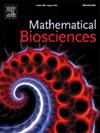Go-or-grow-or-die as a framework for the mathematical modeling of glioblastoma dynamics
IF 1.8
4区 数学
Q2 BIOLOGY
引用次数: 0
Abstract
We investigate a three-dimensional reaction–diffusion model of avascular glioblastoma growth, introducing a new go-or-grow-or-die framework that incorporates reversible phenotypic switching between migratory and proliferative states, while accounting for the contribution of necrotic cells. To model necrotic cell accumulation, a quasi-steady-state approximation is employed, allowing the necrotic population to be expressed as a function of proliferating cell density. Analytical and numerical analyses of the model reveal that the traveling wave speed is consistently lower than that predicted by the classical Fisher–Kolmogorov–Petrovsky–Piskunov equation, highlighting the significance of phenotypic heterogeneity. In particular, we confirm the role of the switching parameter in modulating invasion speed. Approximate wave profiles derived using Canosa’s method show strong agreement with numerical simulations. Furthermore, model predictions are validated against experimental data for the glioblastoma cell line, demonstrating improved accuracy in capturing tumor invasion when both phenotypic switching and necrosis are included. These findings underscore the importance of the go-or-grow-or-die framework in understanding tumor progression and establish a novel, generalizable framework for modeling cancer dynamics.
作为胶质母细胞瘤动力学数学建模的框架
我们研究了无血管胶质母细胞瘤生长的三维反应-扩散模型,引入了一个新的要么生长要么死亡的框架,该框架包含了迁移和增殖状态之间的可逆表型转换,同时考虑了坏死细胞的贡献。为了模拟坏死细胞的积累,采用了准稳态近似,允许坏死细胞群以增殖细胞密度的函数表示。分析和数值分析表明,该模型的行波速度始终低于经典Fisher-Kolmogorov-Petrovsky-Piskunov方程预测的速度,突出了表型异质性的重要性。特别地,我们确认了开关参数在调制入侵速度中的作用。用Canosa方法得到的近似波浪剖面与数值模拟结果非常吻合。此外,针对U87WT胶质母细胞瘤细胞系的实验数据验证了模型预测,表明当包括表型转换和坏死时,捕获肿瘤侵袭的准确性提高。这些发现强调了“要么生长,要么死亡”框架在理解肿瘤进展中的重要性,并为癌症动力学建模建立了一个新的、可推广的框架。
本文章由计算机程序翻译,如有差异,请以英文原文为准。
求助全文
约1分钟内获得全文
求助全文
来源期刊

Mathematical Biosciences
生物-生物学
CiteScore
7.50
自引率
2.30%
发文量
67
审稿时长
18 days
期刊介绍:
Mathematical Biosciences publishes work providing new concepts or new understanding of biological systems using mathematical models, or methodological articles likely to find application to multiple biological systems. Papers are expected to present a major research finding of broad significance for the biological sciences, or mathematical biology. Mathematical Biosciences welcomes original research articles, letters, reviews and perspectives.
 求助内容:
求助内容: 应助结果提醒方式:
应助结果提醒方式:


